- 1Gitlab和AD账号集成,账号登录时报错:Invalid credentials_invalid credentials for
- 22022年武汉科技大学成人高等学历教育招生简章--学历提升、高起专、专升本_武汉科技大学单招中职生吗?
- 3Java基础篇--SecureRandom(安全随机)类_securerandom.nextint
- 4eNSP的安装【最全最详细教程】_ensp下载
- 5【数据结构】顺序表 C语言代码实现 以及realloc的使用_顺序表c语言代码
- 6干货:用好VSCode这13款插件,工作效率提升10倍_vscode design
- 751单片机c语言运算符大全,编程高手写给小白的文章-C语言运算符
- 8【新手】yolov8的trainer.py中部分函数为空_yolov8没有train.py
- 9yolov8_tracking复现_lap numpy
- 10PostgreSql 日期类型处理_postgresql datetime
JSX语法详解
赞
踩
JSX语法详解
本文在官方文档的基础上,进行了扩展扩展补充和一些解读。基本涵盖了JSX语法的细枝末节,JSX语法本身并不复杂,也容易掌握。本文供学习参考使用。
一、基础
1、JSX是什么
JSX是一种像下面这样的语法:
const element = <h1>Hello, world!</h1>;- 1
它是一种JavaScript语法扩展,在React中可以方便地用来描述UI。
本质上,JSX为我们提供了创建React元素方法(React.createElement(component, props, ...children))的语法糖(syntactic sugar)。上面的代码实质上等价于:
var element = React.createElement(
"h1",
null,
"Hello, world!"
);- 1
- 2
- 3
- 4
- 5
2、JSX代表JS对象
JSX本身也是一个表达式,在编译后,JSX表达式会变成普通的JavaScript对象。
你可以在if语句或for循环中使用JSX,你可以将它赋值给变量,你可以将它作为参数接收,你也可以在函数中返回JSX。
例如下面的代码:
function getGreeting(user) {
if (user) {
return <h1>Hello, {formatName(user)}!</h1>;
}
return <h1>Hello, Stranger.</h1>;
}- 1
- 2
- 3
- 4
- 5
- 6
上面的代码在if语句中使用JSX,并将JSX作为函数返回值。实际上,这些JSX经过编译后都会变成JavaScript对象。
经过babel会变成下面的js代码:
function test(user) {
if (user) {
return React.createElement(
"h1",
null,
"Hello, ",
formatStr(user),
"!"
);
}
return React.createElement(
"h1",
null,
"Hello, Stranger."
);
}
- 1
- 2
- 3
- 4
- 5
- 6
- 7
- 8
- 9
- 10
- 11
- 12
- 13
- 14
- 15
- 16
3、在JSX中使用JavaScript表达式
在JSX中插入JavaScript表达式十分简单,直接在JSX中将JS表达式用大括号括起来即可。例如:
function formatName(user) {
return user.firstName + ' ' + user.lastName;
}
const user = {
firstName: 'Harper',
lastName: 'Perez'
};
const element = (
<h1>
Hello, {formatName(user)}!
</h1>
);
ReactDOM.render(
element,
document.getElementById('root')
);
- 1
- 2
- 3
- 4
- 5
- 6
- 7
- 8
- 9
- 10
- 11
- 12
- 13
- 14
- 15
- 16
- 17
- 18
- 19
上面的代码中用到了函数调用表达式fromatName(user)。
在JavaScript中,表达式就是一个短语,Javascript解释器会将其计算出一个结果,常量就是最简单的一类表达式。常用的表达式有:
- 变量名;
- 函数定义表达式;
- 属性访问表达式;
- 函数调用表达式;
- 算数表达式;
- 关系表达式;
- 逻辑表达式;
需要注意的是,if语句以及for循环不是JavaScript表达式,不能直接作为表达式写在{}中,但可以先将其赋值给一个变量(变量是一个JavaScript表达式):
function NumberDescriber(props) {
let description;
if (props.number % 2 == 0) {
description = <strong>even</strong>;
} else {
description = <i>odd</i>;
}
return <div>{props.number} is an {description} number</div>;
}- 1
- 2
- 3
- 4
- 5
- 6
- 7
- 8
- 9
4、JSX属性值
你可以使用引号将字符串字面量指定为属性值:
const element = <div tabIndex="0"></div>;- 1
注意这里的”0”是一个字符串字面量。
或者你可以将一个JavaScript表达式嵌在一个大括号中作为属性值:
const element = <img src={user.avatarUrl}></img>;- 1
这里用到的是JavaScript属性访问表达式,上面的代码将编译为:
const element = React.createElement("img", { src: user.avatarUrl });- 1
5、JSX的Children
首先JSX可以是一个不包含Children的empty tag。如:
const element = <img src={user.avatarUrl} />;- 1
JSX也可以像HTML标签一样包含Children:
const element = (
<div>
<h1>Hello!</h1>
<h2>Good to see you here.</h2>
</div>
);- 1
- 2
- 3
- 4
- 5
- 6
这种写法在生成React元素的时候给我们带来了很大的便利,而且能够更加直观地描述UI。不然我们需要像下面这样创建和上面代码等价的React元素:
const element = React.createElement(
"div",
null,
React.createElement(
"h1",
null,
"Hello!"
),
React.createElement(
"h2",
null,
"Good to see you here."
)
);- 1
- 2
- 3
- 4
- 5
- 6
- 7
- 8
- 9
- 10
- 11
- 12
- 13
- 14
tip: React DOM结点使用骆驼拼写法给属性命名
例如:class在JSX中应写作className,tabindex应写作tabIndex。
另外关于JSX的children需要注意的是:
React自定义组件的chilren是不会像固有的HTML标签的子元素那样自动render的,我们看下面的例子:
代码1
class Test extends React.Component {
render() {
return (
<div>
Here is a list:
<ul>
<li>Item 1</li>
<li>Item 2</li>
</ul>
</div>
)
}
};
ReactDOM.render(
<Test />,
document.getElementById('test')
);
- 1
- 2
- 3
- 4
- 5
- 6
- 7
- 8
- 9
- 10
- 11
- 12
- 13
- 14
- 15
- 16
- 17
- 18
以上代码定义的组件中都是build-in组件,类似div、p、ul、li等。它们中的子元素会直接render出来,像下面这样:
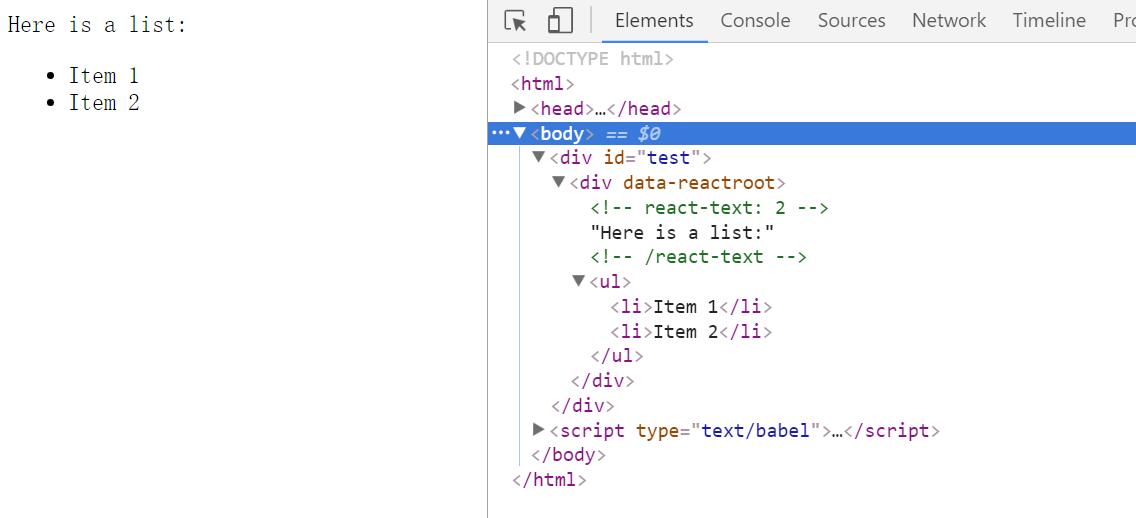
但是如果你使用用户定义组件,比如:
class Test extends React.Component {
render() {
return (
<Em>
Here is a list:
<ul>
<li>Item 1</li>
<li>Item 2</li>
</ul>
</Em>
)
}
};
class Em extends React.Component {
render() {
return (<div></div>);
}
}
ReactDOM.render(
<Test />,
document.getElementById('test')
);
- 1
- 2
- 3
- 4
- 5
- 6
- 7
- 8
- 9
- 10
- 11
- 12
- 13
- 14
- 15
- 16
- 17
- 18
- 19
- 20
- 21
- 22
- 23
- 24
并不能得到跟上面代码1一样的结果,我们得到的只是一个空的div标签:
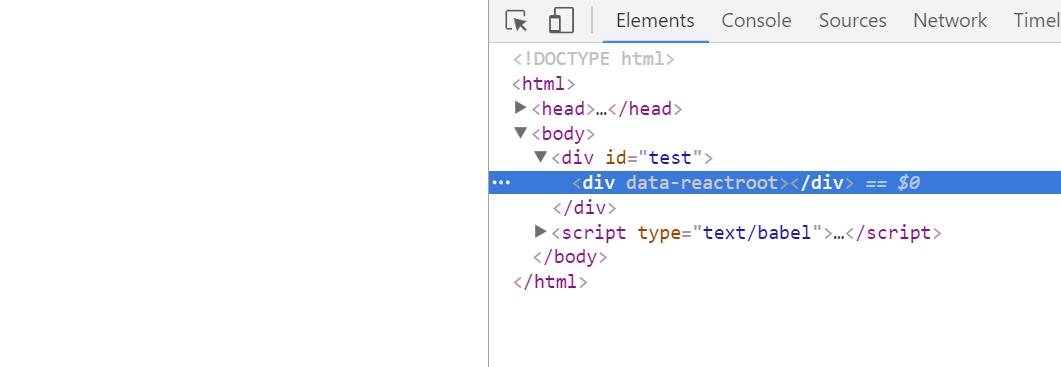
如果你想得到和代码1一样的结果,需要显示地指定props.children,像下面这样:
class Test extends React.Component {
render() {
return (
<Em>
Here is a list:
<ul>
<li>Item 1</li>
<li>Item 2</li>
</ul>
</Em>
)
}
};
class Em extends React.Component {
render() {
return (<div>{this.props.children}</div>);
}
}
ReactDOM.render(
<Test />,
document.getElementById('test')
);
- 1
- 2
- 3
- 4
- 5
- 6
- 7
- 8
- 9
- 10
- 11
- 12
- 13
- 14
- 15
- 16
- 17
- 18
- 19
- 20
- 21
- 22
- 23
- 24
得到下面的结果:
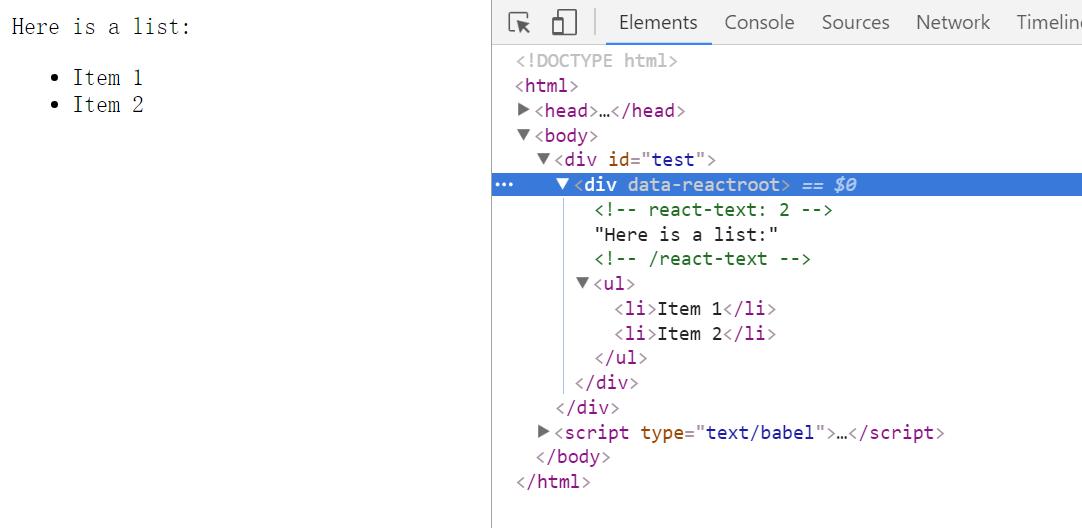
6、JSX可自动防范注入攻击
在JSX中嵌入接收到的内容是安全的,比如:
const danger = response.potentialDanger;
cosnt ele = <h1>{title}</h1>- 1
- 2
- 3
在默认情况下,React DOM会将所有嵌入JSX的值进行编码。这样可以有效避免xss攻击。
我们将以下代码编译后引入html:
class Test extends React.Component {
render() {
let v = "<script><\/script>";
return (
<div>
<h1>{v}</h1>
</div>
)
}
};
ReactDOM.render(
<Test />,
document.getElementById('test')
);- 1
- 2
- 3
- 4
- 5
- 6
- 7
- 8
- 9
- 10
- 11
- 12
- 13
- 14
- 15
得到结果是:
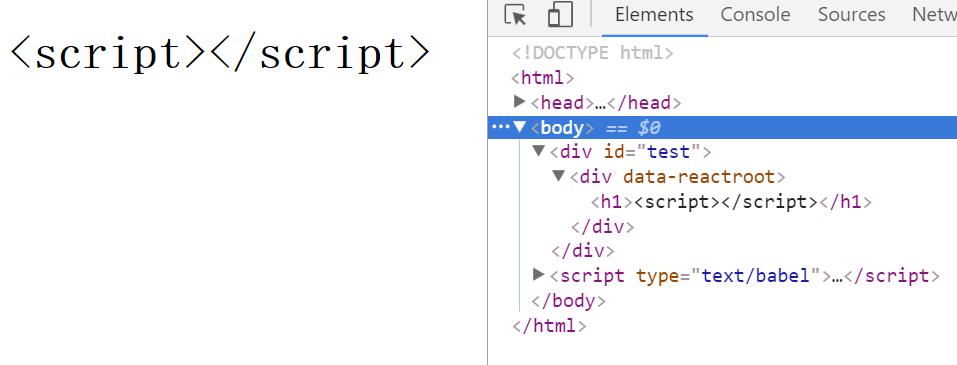
可以看到通过JSX插入的文本自动进行了HTML转义,所以这里插入的是一段文本,而不是<script>标签。这有点类似于Js中的document.createTextNode("...")(实际上我们可以利用document.createTextNode进行HTML转义)。
作为对比,换作使用DOM元素的innerHTML属性:
<!DOCTYPE html>
<html>
<head>
<meta charset="utf-8">
</head>
<body>
<div id="test"></div>
<script type="text/javascript">
document.getElementById("test").innerHTML="<h1><script><\/script><\/h1>";
</script>
</body>
</html>- 1
- 2
- 3
- 4
- 5
- 6
- 7
- 8
- 9
- 10
- 11
- 12
得到结果如下:

注意文本的颜色,此时插入的是一个<script>标签。
如果你很清楚自己在做什么,希望直接将字符串不经转义编码直接插入到HTML文档流,可以使用dangerouslySetInnerHTML属性,这是一个React版的innerHTML,该属性接收一个key为__html的对象,修改代码如下:
class Test extends React.Component {
render() {
let v = {
__html: "<script><\/script>"
};
return (
<div>
<h1 dangerouslySetInnerHTML={v}/>
</div>
)
}
};- 1
- 2
- 3
- 4
- 5
- 6
- 7
- 8
- 9
- 10
- 11
- 12
这次我们插入了<script>标签:
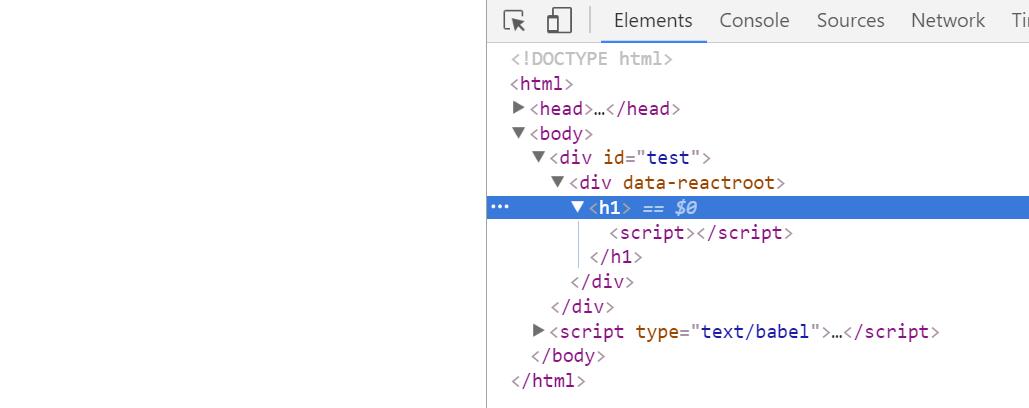
二、进阶
1、JSX中的props
指定JSX中的props有以下几种方式:
(1)使用JavaScript表达式
任何有效的JavaScript表达式都可以作为prop的值,使用的时候将该表达式放在一对大括号中即可:
<MyComponent foo={1 + 2 + 3 + 4} />
<YourComponent clickTodo={(id) => this.props.handleClick(id)} />- 1
- 2
- 3
(2)使用字符串字面量
字符串字面量可以作为prop值,下面的代码是等价的:
<MyComponent message="hello world" />
<MyComponent message={'hello world'} />- 1
- 2
- 3
(3)使用扩展运算符
如果你想将一个prop对象传入JSX,你可以使用扩展运算符...直接将整个prop对象传入。下面的2个组件是等价的:
function App1() {
return <Greeting firstName="Ben" lastName="Hector" />;
}
function App2() {
const props = {firstName: 'Ben', lastName: 'Hector'};
return <Greeting {...props} />;
}- 1
- 2
- 3
- 4
- 5
- 6
- 7
- 8
扩展运算符是一个es6特性。是一种传递属性的十分便利的方式。但请注意不要滥用该运算符,注意不要将一大堆毫不相关的prop一股脑全部传入下面的组件中。
2、JSX中的Children
React组件中有一个特殊的prop–props.children。它指代了JSX表达式中开闭标签中包含的内容。
下面讨论的是几种指定JSX的children的方法:
(1)使用字符串字面量
你可以直接在JSX的开闭标签中写入字符串字面量,组件得到的props.children就是该字符串值。
以下面的代码为例:
<MyComponent>Hello world!</MyComponent>- 1
MyComponent的props.chilren将获得”Hello World!”字符串。通过该方式传入的字符串是未经HTML转义的。实际上你只需要像在HTML标签中写入文本那样就可以了。例如你想在一对<p>标签中写入文本”<script></script>”,HTML和JSX写法是一样的,就像下面这样:
<p><script></script></p>- 1
另外需要注意的是:
JXS会自动删除一行中开头和结尾处的空白符;JSX会自动删除空行;JSX会删除紧邻标签的换行;JSX会删除字符串中的换行;字符串中的换行会被转换成一个空格。
举例来说,下面的JSX代码都是等价的:
<div>Hello World</div>
<div> Hello World </div>
<div>
Hello World
</div>
<div>
Hello
World
</div>
<div>
Hello World
</div>
- 1
- 2
- 3
- 4
- 5
- 6
- 7
- 8
- 9
- 10
- 11
- 12
- 13
- 14
- 15
- 16
- 17
(2)JSX元素作为children
我们同样可以使用JSX元素作为JSX的children,由此生成嵌套组件:
<MyContainer>
<MyFirstComponent />
<MySecondComponent />
</MyContainer>- 1
- 2
- 3
- 4
我们也可以混合使用字符串字面量和JSX作为children:
<El>
Here is a list:
<ul>
<li>Item 1</li>
<li>Item 2</li>
</ul>
</El>- 1
- 2
- 3
- 4
- 5
- 6
- 7
El的props.children将得到一个数组:

可以看到数组的第一个元素就是字符串“Here is a list:”,第二个元素是一个对象(JSX代表JavaScript对象)。
(3)JavaScript表达式
和prop一样,你也可以将任何有效的JavaScript表达式作为children传入,将它放在{}中就可以了。像下面这样:
<MyComponent>{'foo'}</MyComponent>- 1
这里传入了一个常量表达式。
下面使用一个函数调用表达式来生成一个list作为children:
function Item(props) {
return <li>{props.message}</li>;
}
function TodoList() {
const todos = ['finish doc', 'submit pr', 'nag dan to review'];
return (
<ul>
{todos.map((message) => <Item key={message} message={message} />)}
</ul>
);
}- 1
- 2
- 3
- 4
- 5
- 6
- 7
- 8
- 9
- 10
- 11
- 12
当然你也可以在一个字符串children中插入一个JavaScript表达式来生成一个“模板”:
function Hello(props) {
return <div>Hello {props.username}!</div>;
}- 1
- 2
- 3
(4)函数children
首先说明,这不是一种常见的用法。
实际上,传入自定义组件的children并没有严格的限制,只要在React需要render的时候能将它们转换成可以render的东西就行了。
下面是一个函数children的例子:
function ListOfTenThings() {
return (
<Repeat numTimes={10}>
{(index) => <div key={index}>This is item {index} in the list</div>}
</Repeat>
);
}
// Calls the children callback numTimes to produce a repeated component
function Repeat(props) {
let items = [];
for (let i = 0; i < props.numTimes; i++) {
items.push(props.children(i));
}
return <div>{items}</div>;
}
- 1
- 2
- 3
- 4
- 5
- 6
- 7
- 8
- 9
- 10
- 11
- 12
- 13
- 14
- 15
- 16
实际上,我们更通常的情况下是将(index) => <div key={index}>This is item {index} in the list</div>作为一个prop传入子组件。这个例子只是作为一种理解上的扩展。
(5)有关布尔值、Null以及Undefined
布尔值,Null以及Undefined可以作为有效的children,但他们不会被render,下面的JSX表达式都会render一个空的div标签:
<div />
<div></div>
<div>{false}</div>
<div>{null}</div>
<div>{true}</div>- 1
- 2
- 3
- 4
- 5
- 6
- 7
- 8
- 9
关于此有一个有趣的应用,在条件render中,下面的<Header />只有在show为true时才会render:
<div>
{showHeader && <Header />}
<Content />
</div>- 1
- 2
- 3
- 4
3、注意事项
(1)使用JSX时要引入React库
前面已经解释过了,JSX是React.createElement方法的语法糖,因此在使用JSX的作用域中必须引入React库。
如果你使用了JS打包工具,你可以在文件的头部作如下引用:
import React from 'react';- 1
或者你不使用打包工具,也可以直接通过script标签引入React,比如:
//本地
<script src="./react.js"></script>
//或者BootCDN
<script src="http://cdn.bootcss.com/react/15.4.0/react.js"></script>- 1
- 2
- 3
- 4
- 5
此时React将作为一个全局变量被引入,变量名就是’React’。
(2)注意引入JSX中用到的自定义组件
JSX中用到的组件可能并不会在JavaScript中直接引用到,但自定义组件本质上就是一个JS对象,你在JSX中使用的时候,需要首先将该组件引入到当前作用域:
import MyComponent from './MyComponent.js'
...
<Outer>
<MyComponent />
</Outer>- 1
- 2
- 3
- 4
- 5
- 6
- 7
(3)自定义组件首字母一定要大写
JSX中小写字母开头的element代表HTML固有组件如div,span,p,ul等。用户自定义组件首字母一定要大写如<Header>、<Picker>。
(4)元素标签名不能使用表达式
下面的代码将产生错误:
const components = {
photo: PhotoStory,
video: VideoStory
};
function Story(props) {
// Wrong! JSX标签名不能使用表达式
return <components[props.storyType] story={props.story} />;
}- 1
- 2
- 3
- 4
- 5
- 6
- 7
- 8
- 9
如果你需要使用一个表达式来决定元素标签,你应该先将该表达式的值赋给一个大写字母开头的变量:
const components = {
photo: PhotoStory,
video: VideoStory
};
function Story(props) {
// Correct! JSX type can be a capitalized variable.
const SpecificStory = components[props.storyType];
return <SpecificStory story={props.story} />;
}- 1
- 2
- 3
- 4
- 5
- 6
- 7
- 8
- 9
- 10
(5)设置style属性
在设置标签style属性的时候,要注意,我们是将一个描述style的对象以JavaScipt表达式的形式传入。因此应该有2层大括号:
<div style={{color:'red', margin:'10px auto'}}></div>- 1
结语
JSX在React中使用给我们带来了很大的便利,JSX的语法实际上十分简单也很容易掌握。祝学习愉快。


